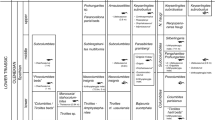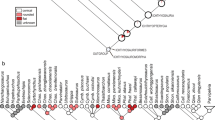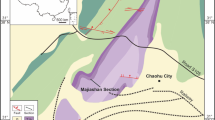Abstract
The incompleteness of the fossil record obscures the origin of many of the more derived clades of vertebrates. One such group is the Ichthyopterygia, a clade of obligatory marine reptiles that appeared in the Early Triassic epoch, without any known intermediates1. Here we describe a basal ichthyosauriform from the upper Lower Triassic (about 248 million years ago) of China, whose primitive skeleton indicates possible amphibious habits. It is smaller than ichthyopterygians and had unusually large flippers that probably allowed limited terrestrial locomotion. It also retained characteristics of terrestrial diapsid reptiles, including a short snout and body trunk2. Unlike more-derived ichthyosauriforms3, it was probably a suction feeder. The new species supports the sister-group relationships between ichthyosauriforms and Hupehsuchia4, the two forming the Ichthyosauromorpha. Basal ichthyosauromorphs are known exclusively from south China, suggesting that the clade originated in the region, which formed a warm5,6 and humid7 tropical archipelago8 in the Early Triassic. The oldest unequivocal record of a sauropterygian is also from the same stratigraphic unit of the region9.
This is a preview of subscription content, access via your institution
Access options
Subscribe to this journal
Receive 51 print issues and online access
$199.00 per year
only $3.90 per issue
Buy this article
- Purchase on Springer Link
- Instant access to full article PDF
Prices may be subject to local taxes which are calculated during checkout




Similar content being viewed by others
Change history
10 November 2014
Jian-Dong Huang was incorrectly listed as an corresponding author instead of Da-Yong Jiang in the HTML (the PDF was correct). This has been corrected in the HTML.
References
McGowan, C. & Motani, R. Ichthyopterygia Vol. 8 (Verlag Dr. Friedrich Pfeil, 2003)
Müller, J. et al. Homeotic effects, somitogenesis and the evolution of vertebral numbers in recent and fossil amniotes. Proc. Natl Acad. Sci. USA 107, 2118–2123 (2010)
Motani, R. et al. Absence of suction feeding ichthyosaurs and its implications for Triassic Mesopelagic paleoecology. PLoS ONE 8, e66075 (2013)
Chen, X.-h., Motani, R., Cheng, L., Jiang, D.-y. & Rieppel, O. The enigmatic marine reptile Nanchangosaurus from the Lower Triassic of Hubei, China and the phylogenetic affinity of Hupehsuchia. PLoS ONE 9, e102361 (2014)
Sun, Y. D. et al. Lethally hot temperatures during the Early Triassic greenhouse. Science 338, 366–370 (2012)
Goudemand, N., Romano, C., Brayard, A., Hochuli, P. A. & Bucher, H. Comment on “Lethally Hot Temperatures During the Early Triassic Greenhouse”. Science 339, 1033 (2013)
Péron, S., Bourquin, S., Fluteau, F. & Guillocheau, F. Paleoenvironment reconstructions and climate simulations of the Early Triassic: impact of the water and sediment supply on the preservation of fluvial systems. Geodin. Acta 18, 431–446 (2005)
Xiao, W. J. & He, H. Q. Early Mesozoic thrust tectonics of the northwest Zhejiang region (Southeast China). Geol. Soc. Am. Bull. 117, 945–961 (2005)
Jiang, D. et al. Early Triassic eosauropterygian Majiashanosaurus discocoracoidis, gen. et sp. nov. (Reptilia, Sauropterygia) from Chaohu, Anhui Province, China. J. Vertebr. Paleontol. 34, 1044–1052 (2014)
Hoffstetter, R. & Gasc, J.-P. in Biology of the Reptilia. Vol 1 (eds Gans, C., Bellairs, A. d’A. & Parsons, T. S. ) 201–310 (Academic, 1969)
Houssaye, A. “Pachyostosis” in aquatic amniotes: a review. Integr. Zool. 4, 325–340 (2009)
Talevi, M. & Fernandez, M. S. Unexpected skeletal histology of an ichthyosaur from the Middle Jurassic of Patagonia: implications for evolution of bone microstructure among secondary aquatic tetrapods. Naturwissenschaften 99, 241–244 (2012)
Carroll, R. L. & Dong, Z. Hupehsuchus, an enigmatic aquatic reptile from the Triassic of China, and the problem of establishing relationships. Phil. Trans. R. Soc. B 331, 131–153 (1991)
Motani, R. et al. First evidence of centralia in Ichthyopterygia reiterating bias from paedomorphic characters on marine reptile phylogenetic reconstruction. J. Vertebr. Paleontol (in the press)
Mazouchova, N., Umbanhowar, P. B. & Goldman, D. I. Flipper-driven terrestrial locomotion of a sea turtle-inspired robot. Bioinspir. Biomim. 8, 026007 (2013)
Marsh, H., Heinsohn, G. E. & Marsh, L. M. Breeding cycle life history and population dynamics of the Dugong Dugong-Dugon Sirenia Dugongidae. Aust. J. Zool. 32, 767–788 (1984)
Rieppel, O. Helveticosaurus zollingeri Peyer (Reptilia Diapsida) skeletal pedomorphosis, functional anatomy and systematic affinities. Palaeontographica Abteilung A 208, 123–152 (1989)
Caldwell, M. W. Limb ontogeny, evolution and aquatic adaptation in lepidosauromorph diapsids. J. Vertebr. Paleontol. 14, 19A (1994)
Motani, R. et al. Status of Chaohusaurus chaoxianensis (Young and Dong, 1972). J. Vertebr. Paleontol (in the press)
Motani, R., Jiang, D., Tintori, A., Rieppel, O. & Chen, G. B. Terrestrial origin of viviparity indicated by the oldest embryonic fossil of Mesozoic marine reptiles. PLoS One 9, e8B640 (2014)
Boettcher, R. New information on the reproductive biology of Ichthyosaurs (Reptilia). Stuttgarter Beitraege zur Naturkunde Serie B 164, 1–51 (1990)
Motani, R., Rothschild, B. M. & Wahl, W. Large eyeballs in diving ichthyosaurs. Nature 402, 747 (1999)
Callaway, J. M. & Brinkman, D. B. Ichthyosaurs (Reptilia, Ichthyosauria) from the Lower and Middle Triassic Sulfur Mountain Formation, Wapiti Lake Area, British-Columbia, Canada. Can. J. Earth Sci. 26, 1491–1500 (1989)
Cox, C. B. & Smith, D. G. Review of Triassic vertebrate faunas of Svalbard. Geol. Mag. 110, 405–418 (1973)
Nicholls, E. L. & Brinkman, D. B. in Vertebrate Fossils and the Evolution of Scientific Concepts (ed. Sarjeant, W. A. S. ) 521–535 (Gordon and Breach, 1995)
Harland, W. B. The geology of svalbard. Mem. Geol. Soc. Lond. 17, 1–521 (1997)
Carroll, R. L. Evolutionary constraints in aquatic diapsid reptiles. Spec. Pap. Palaeontol. 33, 145–155 (1985)
Vermeij, G. J. & Dudley, R. Why are there so few evolutionary transitions between aquatic and terrestrial ecosystems? Biol. J. Linn. Soc. 70, 541–554 (2000)
Sun, Z. M. et al. Magnetostratigraphy of the Lower Triassic beds from Chaohu (China) and its implications for the Induan-Olenekian stage boundary. Earth Planet. Sci. Lett. 279, 350–361 (2009)
Acknowledgements
We thank T. Sato for the excellent preparation of the holotype. The study was enabled by grants from the National Geographic Society Committee for Research and Exploration (8669-09) to R.M., Project 40920124002 and 41372016 from the National Natural Science Foundation of China to D.-Y.J., Project 123102 from State Key Laboratory of Palaeobiology and Stratigraphy (Nanjing Institute of Geology and Palaeontology, CAS) to D.-Y.J., Project 20120001110072 from the Research Fund for the Doctoral Program of Higher Education to D.-Y.J., and a Project of Protection for Geological Heritage from Department of Land and Resource of Anhui Province to G.-B.C.
Author information
Authors and Affiliations
Contributions
R.M. conceived the study, participated in the relevant fossil excavations, ran all analyses, drew all figures except Fig. 1b, and wrote the manuscript. D.-Y.J. conceived the study, supervised the relevant fossil excavations and preparations, drew Fig. 1b, and revised the manuscript; G.-B.C. conceived the study and supervised off-season fossil collections; A.T. conceived the study, participated in the relevant fossil excavations, and revised the manuscript; O.R. conceived the study, participated in the relevant fossil excavations, and revised the manuscript; C.J. provided an unpublished data matrix, participated in the relevant fossil excavations, and revised the manuscript; J.-D.H. helped supervise off-season fossil collections.
Corresponding authors
Ethics declarations
Competing interests
The authors declare no competing financial interests.
Extended data figures and tables
Extended Data Figure 1 Phylogenetic hypothesis of diapsid relationships when aquatic adaptations are recoded as ambiguous.
Strict consensus of two most parsimonious trees (tree length (TL) = 805, consistency index (CI) = 0.317, retention index (RI) = 0.587) obtained by a heuristic search in PAUP* 4b10 (hold = 10, nreps = 100, addseq = random, swap = tbr). Numbers associated with clades are Bremer support values calculated in TNT 1.1. Original tree of Fig. 4a. Phylogenetic tree is based on the data described in Supplementary Information.
Extended Data Figure 2 Phylogenetic hypothesis of diapsid relationships when aquatic adaptations are recoded normally.
Strict consensus of 20 most parsimonious trees (TL = 839, CI = 0.311, RI = 0.612) obtained by a heuristic search in PAUP* 4b10 (hold = 10, nreps = 100, addseq = random, swap = tbr). Numbers associated with clades are Bremer support values calculated in TNT 1.1. Original tree of Fig. 4b. Phylogenetic tree is based on the data described in Supplementary Information.
Extended Data Figure 3 Phylogenetic hypothesis of Ichthyosauriformes.
Strict consensus of 82 most parsimonious trees (TL = 527, CI = 0.423, RI = 0.796) obtained by a heuristic search in PAUP* 4b10 (hold = 10, nreps = 100, addseq = random, swap = tbr). Numbers associated with clades are Bremer support values calculated in TNT 1.1. Original tree of Fig. 4c. Phylogenetic tree is based on the data described in Supplementary Information.
Supplementary information
Supplementary Data
This file contains data for the relationships of diapsids, with aquatic adaptations codes as ambiguous (Figure 4a). (PDF 489 kb)
Rights and permissions
About this article
Cite this article
Motani, R., Jiang, DY., Chen, GB. et al. A basal ichthyosauriform with a short snout from the Lower Triassic of China. Nature 517, 485–488 (2015). https://doi.org/10.1038/nature13866
Received:
Accepted:
Published:
Issue Date:
DOI: https://doi.org/10.1038/nature13866
This article is cited by
-
Ontogenetic variation in the cranium of Mixosaurus cornalianus, with implications for the evolution of ichthyosaurian cranial development
Swiss Journal of Palaeontology (2023)
-
A new long-snouted marine reptile from the Middle Triassic of China illuminates pachypleurosauroid evolution
Scientific Reports (2023)
-
Extended embryo retention and viviparity in the first amniotes
Nature Ecology & Evolution (2023)
-
Subaqueous foraging among carnivorous dinosaurs
Nature (2022)
-
A globally distributed durophagous marine reptile clade supports the rapid recovery of pelagic ecosystems after the Permo-Triassic mass extinction
Communications Biology (2022)
Comments
By submitting a comment you agree to abide by our Terms and Community Guidelines. If you find something abusive or that does not comply with our terms or guidelines please flag it as inappropriate.



